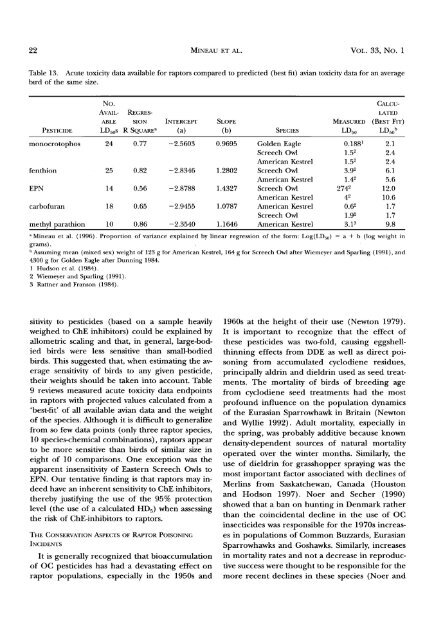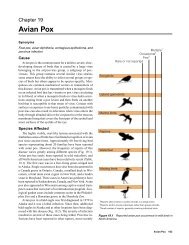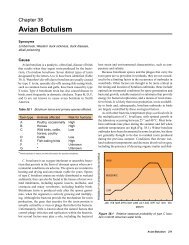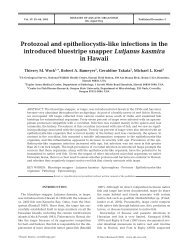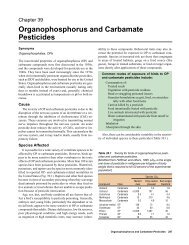poisoning of raptors with organophosphorus and carbamate ...
poisoning of raptors with organophosphorus and carbamate ...
poisoning of raptors with organophosphorus and carbamate ...
You also want an ePaper? Increase the reach of your titles
YUMPU automatically turns print PDFs into web optimized ePapers that Google loves.
22 MINEAU ET AL. VOL. 33, NO. 1<br />
Table 13. Acute toxicity data available for <strong>raptors</strong> compared to predicted (best fit) avian toxicity data for an average<br />
bird <strong>of</strong> the same size.<br />
PESTICIDE<br />
No.<br />
CALCU-<br />
AVAIL- REGRES- LATED<br />
AI3LE SION INTERCEPT SLOPE ME^SU•ED (BEST FIT)<br />
LD5os R SQUARE a (a) (b) SPECIES LD5o LD5o b<br />
monocrotophos 24 0.77 -2.5603 0.9695 Golden Eagle 0.188 • 2.1<br />
Screech Owl 1.52 2.4<br />
American Kestrel 1.52 2.4<br />
fenthion 25 0.82 -2.8346 1.2802 Screech Owl 3.92 6.1<br />
American Kestrel 1.42 5.6<br />
EPN 14 0.56 -2.8788 1.4327 Screech Owl 2742 12.0<br />
American Kestrel 42 10.6<br />
carb<strong>of</strong>uran 18 0.65 -2.9455 1.0787 American Kestrel 0.62 1.7<br />
Screech Owl 1.92 1.7<br />
methyl parathion 10 0.86 -2.3540 1.1646 American Kestrel 3.1 s 9.8<br />
a Mineau et al. (1996). Proportion <strong>of</strong> variance explained by linear regression <strong>of</strong> the form: Log(LD50 ) = a + b (log weight in<br />
grams).<br />
• Assuming mean (mixed sex) weight <strong>of</strong> 123 g for American Kestrel, 164 g for Screech Owl after Wiemeyer <strong>and</strong> Sparling (1991), <strong>and</strong><br />
4300 g for Golden Eagle after Dunning 1984.<br />
1 Hudson et al. (1984).<br />
2 Wiemeyer <strong>and</strong> Sparling (1991).<br />
3 Rattner <strong>and</strong> Franson (1984).<br />
sitivity to pesticides (based on a sample heavily<br />
weighed to ChE inhibitors) could be explained by<br />
allometric scaling <strong>and</strong> that, in general, large-bodied<br />
birds were less sensitive than small-bodied<br />
birds. This suggested that, when estimating the average<br />
sensitivity <strong>of</strong> birds to any given pesticide,<br />
their weights should be taken into account. Table<br />
9 reviews measured acute toxicity data endpoints<br />
in <strong>raptors</strong> <strong>with</strong> projected values calculated from a<br />
'best-fit' <strong>of</strong> all available avian data <strong>and</strong> the weight<br />
<strong>of</strong> the species. Although it is difficult to generalize<br />
from so few data points (only three raptor species,<br />
10 species-chemical combinations), <strong>raptors</strong> appear<br />
to be more sensitive than birds <strong>of</strong> similar size in<br />
eight <strong>of</strong> 10 comparisons. One exception was the<br />
apparent insensitivity <strong>of</strong> Eastern Screech Owls to<br />
EPN. Our tentative finding is that <strong>raptors</strong> may indeed<br />
have an inherent sensitivity to ChE inhibitors,<br />
thereby justifying the use <strong>of</strong> the 95% protection<br />
level (the use <strong>of</strong> a calculated HDs) when assessing<br />
the risk <strong>of</strong> ChE-inhibitors to <strong>raptors</strong>.<br />
THE CONSERVATION ASPECTS OF RAPTOR POISONING<br />
INCIDENTS<br />
It is generally recognized that bioaccumulation<br />
<strong>of</strong> OC pesticides has had a devastating effect on<br />
raptor populations, especially in the 1950s <strong>and</strong><br />
1960s at the height <strong>of</strong> their use (Newton 1979).<br />
It is important to recognize that the effect <strong>of</strong><br />
these pesticides was two-fold, causing eggshellthinning<br />
effects from DDE as well as direct <strong>poisoning</strong><br />
from accumulated cyclodiene residues,<br />
principally aldrin <strong>and</strong> dieldrin used as seed treatments.<br />
The mortality <strong>of</strong> birds <strong>of</strong> breeding age<br />
from cyclodiene seed treatments had the most<br />
pr<strong>of</strong>ound influence on the population dynamics<br />
<strong>of</strong> the Eurasian Sparrowhawk in Britain (Newton<br />
<strong>and</strong> Wyllie 1992). Adult mortality, especially in<br />
the spring, was probably additive because known<br />
density-dependent sources <strong>of</strong> natural mortality<br />
operated over the winter months. Similarly, the<br />
use <strong>of</strong> dieldrin for grasshopper spraying was the<br />
most important factor associated <strong>with</strong> declines <strong>of</strong><br />
Merlins from Saskatchewan, Canada (Houston<br />
<strong>and</strong> Hodson 1997). Noer <strong>and</strong> Secher (1990)<br />
showed that a ban on hunting in Denmark rather<br />
than the coincidental decline in the use <strong>of</strong> OC<br />
insecticides was responsible for the 1970s increases<br />
in populations <strong>of</strong> Common Buzzards, Eurasian<br />
Sparrowhawks <strong>and</strong> Goshawks. Similarly, increases<br />
in mortality rates <strong>and</strong> not a decrease in reproduc-<br />
tive success were thought to be responsible for the<br />
more recent declines in these species (Noer <strong>and</strong>


